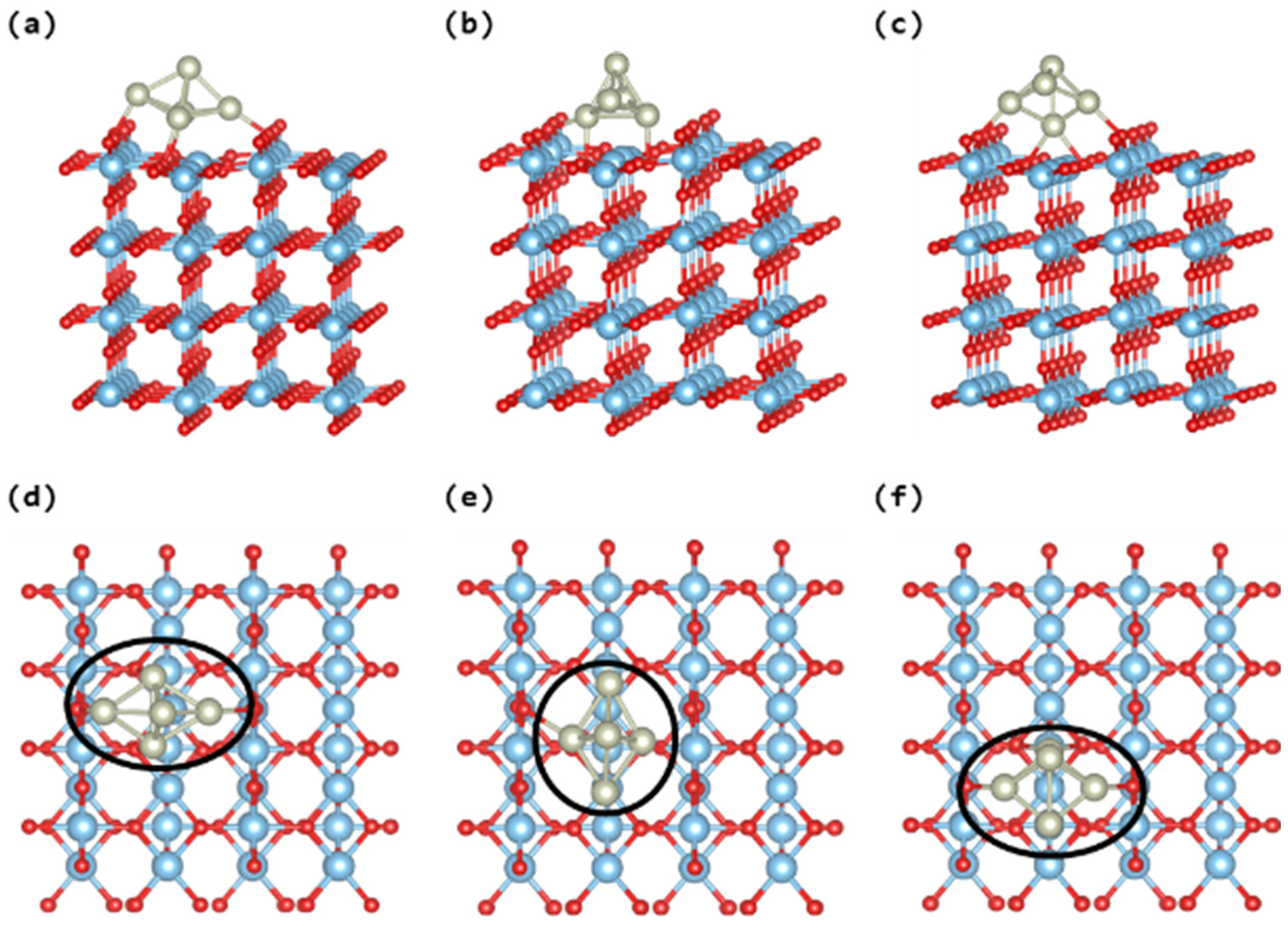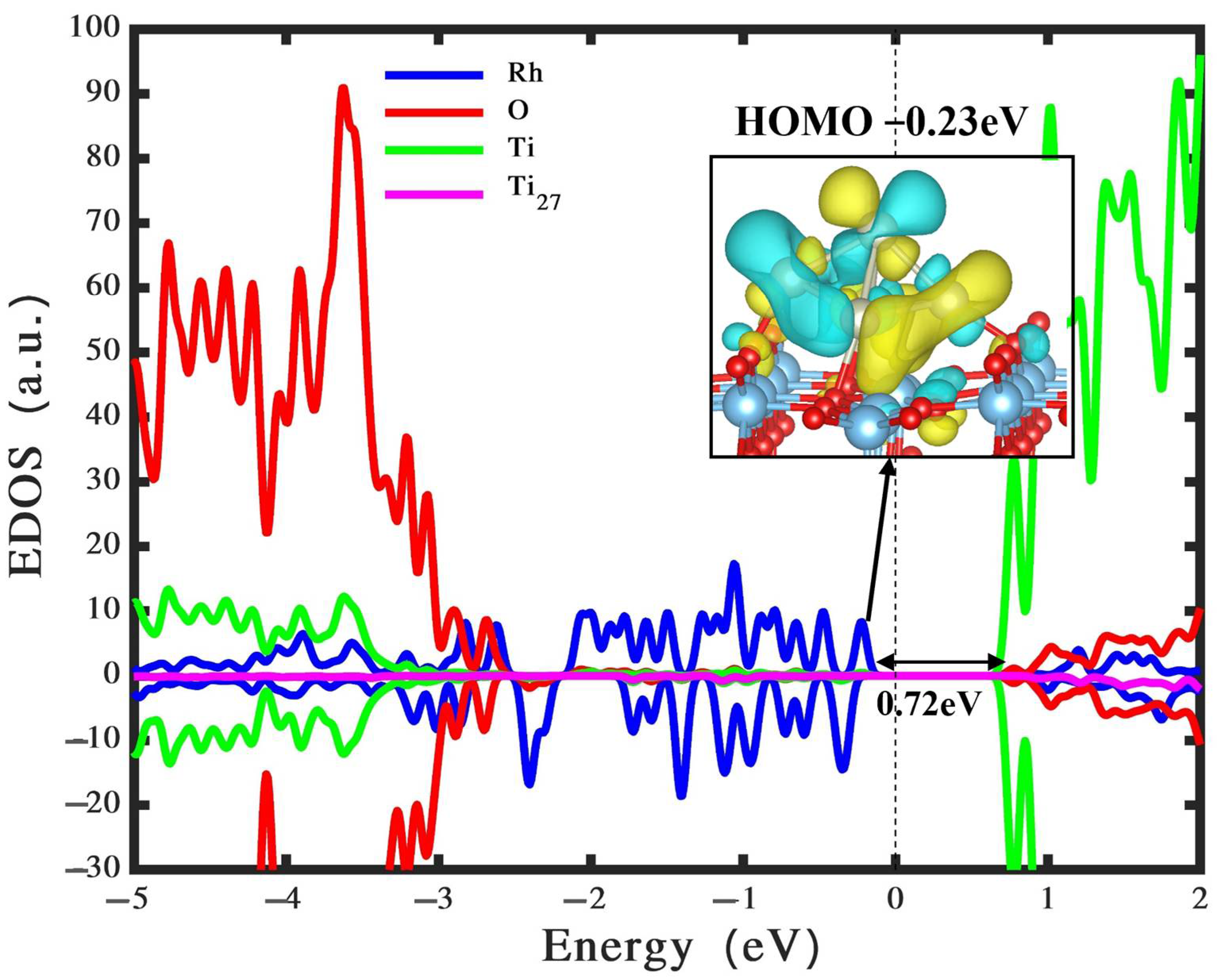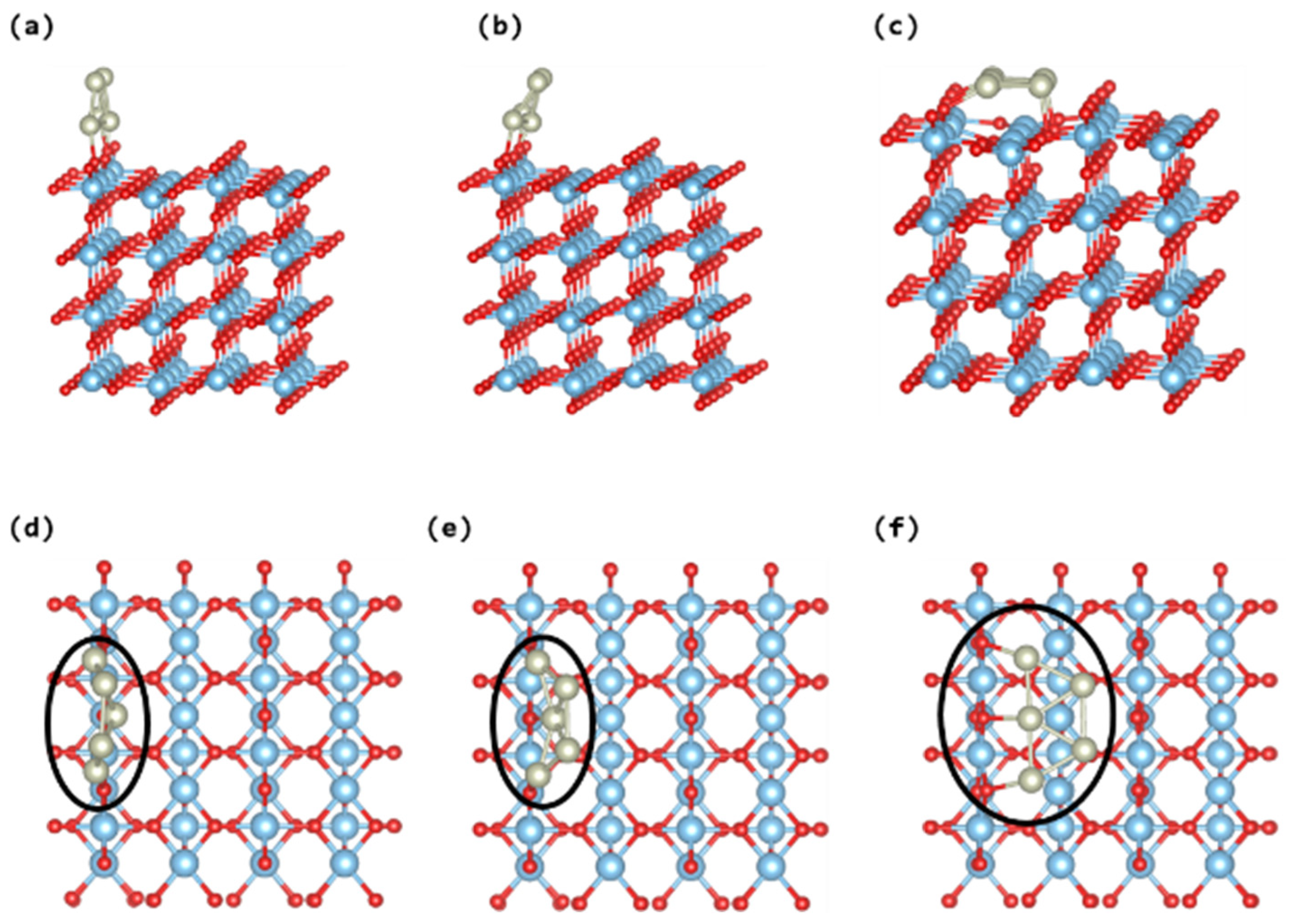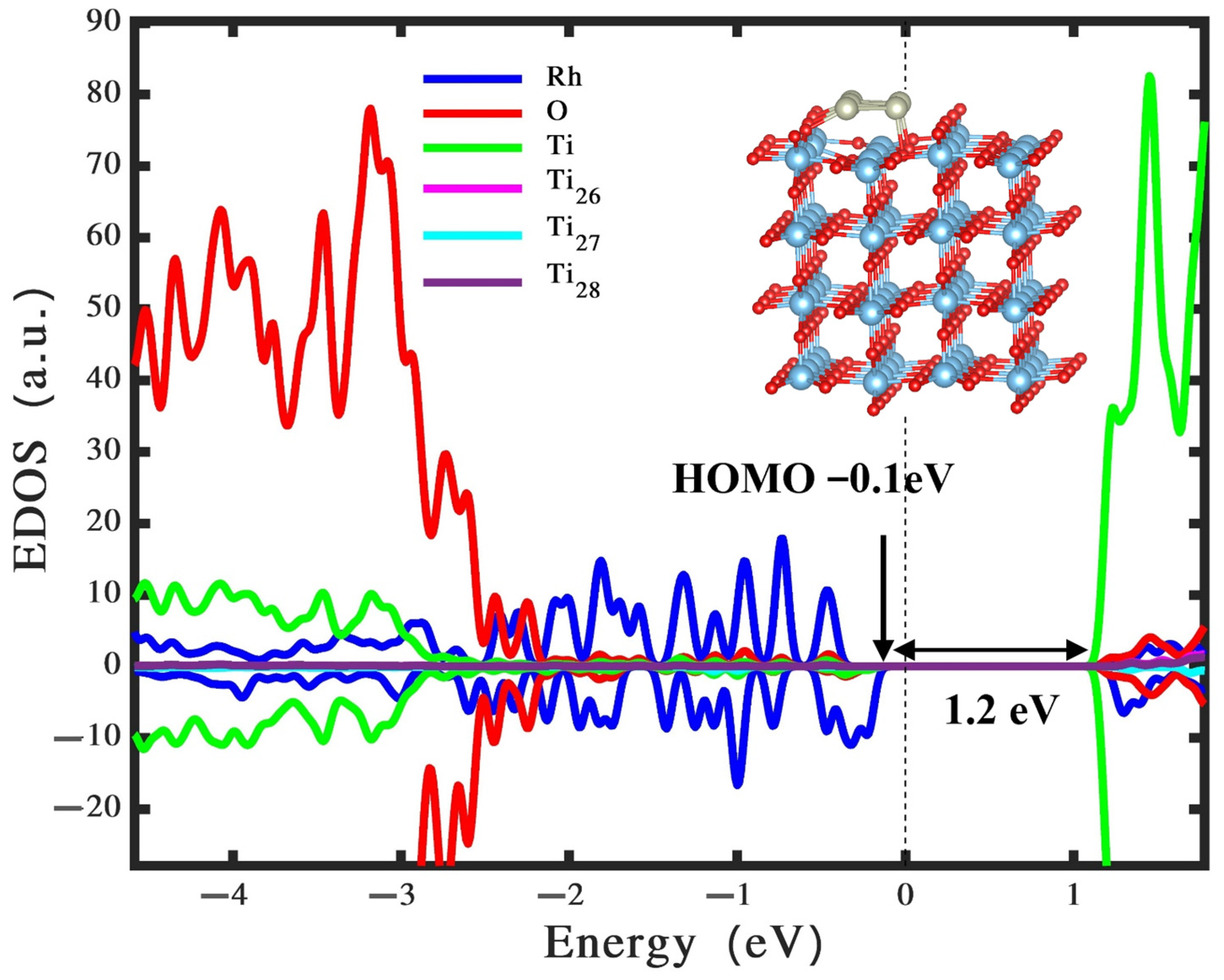Geometrical Stabilities and Electronic Structures of Rh5 Nanoclusters on Rutile TiO2 (110) for Green Hydrogen Production
Abstract
1. Introduction
2. Computational Details
3. Results and Discussion
3.1. Isolated Rh5 Nanoclusters
3.2. Bipyramidal Rh5 Nanocluster Loaded on TiO2
3.3. Trapezoidal Rh5 Nanocluster Loaded on TiO2
3.4. Bipyramidal Rh5 Nanocluster Loaded on Defective TiO2
4. Concluding Remarks
Supplementary Materials
Funding
Data Availability Statement
Acknowledgments
Conflicts of Interest
References
- Fujishima, A.; Honda, K. Electrochemical Photolysis of Water at a Semiconductor Electrode. Nature 1972, 238, 38–40. [Google Scholar] [CrossRef] [PubMed]
- Akira, F.; Rao, T.N.; Tryk, D.A. Titanium dioxide photocatalysis. J. Photochem. Photobiol. C 2000, 1, 1–21. [Google Scholar]
- Ochiai, T.; Fujishima, A. Photoelectrochemical properties of TiO2 photocatalyst and its applications for environmental purification. J. Photochem. Photobiol. C Photochem. Rev. 2012, 13, 247–262. [Google Scholar] [CrossRef]
- Maeda, K. Z-scheme water splitting using two different semiconductor photocatalysts. ACS Catal. 2013, 3, 1486–1503. [Google Scholar] [CrossRef]
- Ma, Y.; Wang, X.; Jia, Y.; Chen, X.; Han, H.; Li, C. Titanium dioxide-based nanomaterials for photocatalytic fuel generations. Chem. Rev. 2014, 114, 9987–10043. [Google Scholar] [CrossRef] [PubMed]
- Chen, X.; Mao, S.S. Titanium dioxide nanomaterials: Synthesis, properties, modifications and applications. Chem. Rev. 2007, 107, 2891–2959. [Google Scholar] [CrossRef]
- Yang, J.; Wang, D.; Han, H.; Li, C. Roles of cocatalysts in photocatalysis and photoelectrocatalysis. Acc. Chem. Res. 2013, 46, 1900–1909. [Google Scholar] [CrossRef]
- Ran, J.; Zhang, J.; Yu, J.; Jaroniec, M.; Qiao, S.Z. Earth-abundant cocatalysts for semiconductor-based photocatalytic water splitting. Chem. Soc. Rev. 2014, 43, 7787–7812. [Google Scholar] [CrossRef]
- Patrocinio, A.O.T.; Schneider, J.; França, M.D.; Santos, L.M.; Caixeta, B.P.; Machado, A.E.H.; Bahnemann, D.W. Charge carrier dynamics and photocatalytic behavior of TiO2 nanopowders submitted to hydrothermal or conventional heat treatment. RSC Adv. 2015, 5, 70536–70545. [Google Scholar] [CrossRef]
- Cowan, A.J.; Tang, J.; Leng, W.; Durrant, J.R.; Klug, D.R. Water splitting by nanocrystalline TiO2 in a complete photoelectrochemical cell exhibits efficiencies limited by charge recombination. J. Phys. Chem. C 2010, 114, 4208–4214. [Google Scholar] [CrossRef]
- Ni, M.; Leung, M.K.H.; Leung, D.Y.C.; Sumathy, K. A review and recent developments in photocatalytic water-splitting using TiO2 for hydrogen production. Renew. Sustain. Energy Rev. 2007, 11, 401–425. [Google Scholar] [CrossRef]
- Tezuka, Y.; Shin, S.; Ishii, T.; Ejima, T.; Suzuki, S.; Sato, S. Photoemission and Bremsstrahlung Isochromat Spectroscopy Studies of TiO2 (Rutile) and SrTiO3. J. Phys. Soc. Jpn. 1994, 63, 347–357. [Google Scholar] [CrossRef]
- Kavan, L.; Grätzel, M.; Gilbert, S.E.; Klemenz, C.; Scheel, H.J. Electrochemical and photoelectrochemical investigation of single-crystal anatase. J. Am. Chem. Soc. 1996, 118, 6716–6723. [Google Scholar] [CrossRef]
- Chainarong, S.; Sikong, L.; Pavasupree, S.; Niyomwas, S. Synthesis and characterization of nitrogen-doped TiO2 nanomaterials for photocatalytic activities under visible light. Energy Procedia 2011, 9, 418–427. [Google Scholar] [CrossRef]
- Fujii, H.; Inata, K.; Ohtaki, M.; Eguchi, K.; Arai, H. Synthesis of TiO2/CdS nanocomposite via TiO2 coating on CdS nanoparticles by compartmentalized hydrolysis of Ti alkoxide. J. Mater. Sci. 2001, 36, 527–532. [Google Scholar] [CrossRef]
- Mba, M.; D’Acunzo, M.; Salice, P.; Carofiglio, T.; Maggini, M.; Caramori, S.; Campana, A.; Aliprandi, A.; Argazzi, R.; Carli, S.; et al. Sensitization of nanocrystalline TiO2 with multibranched organic dyes and co(III)/(II) Mediators: Strategies to improve charge collection efficiency. J. Phys. Chem. C 2013, 117, 19885–19896. [Google Scholar] [CrossRef]
- Klein, M.; Nadolna, J.; Gołąbiewska, A.; Mazierski, P.; Klimczuk, T.; Remita, H.; Zaleska-Medynska, A. The effect of metal cluster deposition route on structure and photocatalytic activity of mono- and bimetallic nanoparticles supported on TiO2 by radiolytic method. Appl. Surf. Sci. 2016, 378, 37–48. [Google Scholar] [CrossRef]
- Zhang, H.; Ming, H.; Lian, S.; Huang, H.; Li, H.; Zhang, L.; Liu, Y.; Kang, Z.; Lee, S.T. Fe2O3/carbon quantum dots complex photocatalysts and their enhanced photocatalytic activity under visible light. Dalton Trans. 2011, 40, 10822–10825. [Google Scholar] [CrossRef]
- Liang, C.H.; Hou, M.F.; Zhou, S.G.; Li, F.B.; Liu, C.S.; Liu, T.X.; Gao, Y.X.; Wang, X.G.; Lü, J.L. The effect of erbium on the adsorption and photodegradation of orange I in aqueous Er3+-TiO2 suspension. J. Hazard. Mater. 2006, 138, 471–478. [Google Scholar] [CrossRef]
- Greeley, J.; Jaramillo, T.F.; Bonde, J.; Chorkendorff, I.; Nørskov, J.K. Computational high-throughput screening of electrocatalytic materials for hydrogen evolution. Nat. Mater. 2006, 5, 909–913. [Google Scholar] [CrossRef]
- Nørskov, J.K.; Bligaard, T.; Logadottir, A.; Kitchin, J.R.; Chen, J.G.; Pandelov, S.; Stimming, U. Trends in the Exchange Current for Hydrogen Evolution. J. Electrochem. Soc. 2005, 152, J23. [Google Scholar] [CrossRef]
- Choi, W.; Termin, A.; Hoffmann, M.R. The Role of Metal Ion Dopants in Quantum-Sized TiO2: Correlation between Photoreactivity and Charge Carrier Recombination Dynamics. J. Phys. Chem. 2002, 98, 13669–13679. [Google Scholar] [CrossRef]
- Kitano, S.; Hashimoto, K.; Kominami, H. Photocatalytic degradation of 2-propanol over metal-ion-loaded titanium(IV) oxide under visible light irradiation: Effect of physical properties of nano-crystalline titanium(IV) oxide. Appl. Catal. B 2011, 101, 206–211. [Google Scholar] [CrossRef]
- Xing, J.; Chen, J.F.; Li, Y.H.; Yuan, W.T.; Zhou, Y.; Zheng, L.R.; Wang, H.F.; Hu, P.; Wang, Y.; Zhao, H.J.; et al. Stable isolated metal atoms as active sites for photocatalytic hydrogen evolution. Chem.-A Eur. J. 2014, 20, 2138–2144. [Google Scholar] [CrossRef]
- Kaise, M.; Nagai, H.; Tokuhashi, K.; Kondo, S.; Nimura, S.; Kikuchi, O. Electron Spin Resonance Studies of Photocatalytic Interface Reactions of Suspended M/TiO2 (M = Pt, Pd, Ir, Rh, Os, or Ru) with Alcohol and Acetic Acid in Aqueous Media. Langmuir 1994, 10, 1345–1347. [Google Scholar] [CrossRef]
- Sathish, M.; Viswanathan, B.; Viswanath, R.P. Alternate synthetic strategy for the preparation of CdS nanoparticles and its exploitation for water splitting. Int. J. Hydrogen Energy 2006, 31, 891–898. [Google Scholar] [CrossRef]
- Futschek, T.; Marsman, M.; Hafner, J. Structural and magnetic isomers of small Pd and Rh clusters: An ab initio density functional study. J. Phys. Condens. Matter 2005, 17, 5927–5963. [Google Scholar] [CrossRef]
- Buceta, D.; Piñeiro, Y.; Vázquez-Vázquez, C.; Rivas, J.; López-Quintela, M.A. Metallic clusters: Theoretical background, properties and synthesis in microemulsions. Catalysts 2014, 4, 356–374. [Google Scholar] [CrossRef]
- Perron, H.; Domain, C.; Roques, J.; Drot, R.; Simoni, E.; Catalette, H. Optimisation of accurate rutile TiO2 (110), (100), (101) and (001) surface models from periodic DFT calculations. Theor. Chem. Acc. 2007, 117, 565–574. [Google Scholar] [CrossRef]
- Ramamoorthy, M.; Vanderbilt, D.; King-Smith, R.D. First-principles calculations of the energetics of stoichiometric TiO2 surfaces. Phys. Rev. B 1994, 49, 16721–16727. [Google Scholar] [CrossRef]
- Grimme, S.; Antony, J.; Ehrlich, S.; Krieg, H. A consistent and accurate ab initio parametrization of density functional dispersion correction (DFT-D) for the 94 elements H-Pu. J. Chem. Phys. 2010, 132, 154104. [Google Scholar] [CrossRef] [PubMed]
- López-Caballero, P.; Ramallo-López, J.M.; Giovanetti, L.J.; Buceta, D.; Miret-Artés, S.; López-Quintela, M.A.; Requejo, F.G.; de Lara-Castells, M.P. Exploring the properties of Ag5-TiO2 interfaces: Stable surface polaron formation, UV-Vis optical response, and CO2 photoactivation. J. Mater. Chem. A Mater. 2020, 8, 6842–6853. [Google Scholar] [CrossRef]
- Alotaibi, M.; Wu, Q.; Lambert, C. Computational Studies of Ag 5 Atomic Quantum Clusters Deposited on Anatase and Rutile TiO2 Surfaces. Appl. Surf. Sci. 2022, 613, 156054. [Google Scholar] [CrossRef]
- Heyd, J.; Scuseria, G.E. Influence of the exchange screening parameter on the performance of screened hybrid functionals. J. Chem. Phys. 2006, 125, 224106. [Google Scholar] [CrossRef]
- Heyd, J.; Scuseria, G.E.; Ernzerhof, M. Hybrid functionals based on a screened Coulomb potential. J. Chem. Phys. 2003, 118, 8207–8215. [Google Scholar] [CrossRef]
- Kresse, G.; Furthmüller, J. Efficiency of ab-initio total energy calculations for metals and semiconductors using a plane-wave basis set. Comput. Mater. Sci. 1996, 6, 15–50. [Google Scholar] [CrossRef]
- Kresse, G.; Furthmüller, J. Efficient iterative schemes for ab initio total-energy calculations using a plane-wave basis set. Phys. Rev. B 1996, 54, 11169–11186. [Google Scholar] [CrossRef]
- Kresse, G.; Hafner, J. Ab initio molecular-dynamics simulation of the liquid-metalamorphous- semiconductor transition in germanium. Phys. Rev. B 1994, 49, 14251–14269. [Google Scholar] [CrossRef]
- Kresse, D.; Joubert, D. From ultrasoft pseudopotentials to the projector augmented-wave method. Phys. Rev. B 1999, 59, 1758–1775. [Google Scholar] [CrossRef]
- Blöchl, P.E. Projector augmented-wave method. Phys. Rev. B 1994, 50, 17953–17979. [Google Scholar] [CrossRef]
- Perdew, J.P.; Burke, K.; Ernzerhof, M. Generalized gradient approximation made simple. Phys. Rev. Lett. 1996, 77, 3865–3868. [Google Scholar] [CrossRef] [PubMed]
- Seriani, N.; Pinilla, C.; Crespo, Y. Presence of gap states at Cu/TiO2 anatase surfaces: Consequences for the photocatalytic activity. J. Phys. Chem. C 2015, 119, 6696–6702. [Google Scholar] [CrossRef]
- Morgan, B.J.; Watson, G.W. A DFT + U description of oxygen vacancies at the TiO2 rutile (1 1 0) surface. Surf. Sci. 2007, 601, 5034–5041. [Google Scholar] [CrossRef]
- Morgan, B.J.; Watson, G.W. A density functional theory + u study of Oxygen vacancy formation at the (110), (100), (101), and (001) surfaces of rutile TiO2. J. Phys. Chem. C 2009, 113, 7322–7328. [Google Scholar] [CrossRef]
- Antony, A.; Hakanoglu, C.; Asthagiri, A.; Weaver, J.F. Dispersion-corrected density functional theory calculations of the molecular binding of n-alkanes on Pd(111) and PdO(101). J. Chem. Phys. 2012, 136, 054702. [Google Scholar] [CrossRef]
- Monkhorst, H.J.; Pack, J.D. Special points for Brillonin-zone integrations. Phys. Rev. B 1976, 13, 5188–5192. [Google Scholar] [CrossRef]
- López-Caballero, P.; Miret-Artés, S.; Mitrushchenkov, A.O.; De Lara-Castells, M.P. Ag5-induced stabilization of multiple surface polarons on perfect and reduced TiO2rutile (110). J. Chem. Phys. 2020, 153, 164702. [Google Scholar] [CrossRef]
- López-Caballero, P.; Hauser, A.W.; De Lara-Castells, M.P. Exploring the Catalytic Properties of Unsupported and TiO2-Supported Cu5 Clusters: CO2 Decomposition to CO and CO2 Photoactivation. J. Phys. Chem. C 2019, 123, 23064–23074. [Google Scholar] [CrossRef]
- Malik, A.S.; Liu, T.; Rittiruam, M.; Saelee, T.; Da Silva, J.L.; Praserthdam, S.; Praserthdam, P. On a high photocatalytic activity of high-noble alloys Au–Ag/TiO2 catalysts during oxygen evolution reaction of water oxidation. Sci. Rep. 2022, 12, 2604. [Google Scholar] [CrossRef]
- Heffner, H.; Faccio, R.; López, I. C–doped TiO2(B): A density functional theory characterization. Appl. Surf. Sci. 2021, 551, 149479. [Google Scholar] [CrossRef]
- Jin, C.; Dai, Y.; Wei, W.; Ma, X.; Li, M.; Huang, B. Effects of single metal atom (Pt, Pd, Rh and Ru) adsorption on the photocatalytic properties of anatase TiO2. Appl. Surf. Sci. 2017, 426, 639–646. [Google Scholar] [CrossRef]
- Momma, K.; Izumi, F. VESTA: A three-dimensional visualization system for electronic and structural analysis. J. Appl. Crystallogr. 2008, 41, 653–658. [Google Scholar] [CrossRef]
- Wu, Q.; Hou, S.; Buceta, D.; Ordoñez, H.J.L.; López-Quintela, M.A.; Lambert, C.J. Tuning the surface states of TiO2 using Cu5 atomic clusters. Appl. Surf. Sci. 2022, 594, 153455. [Google Scholar] [CrossRef]
- Ren, Y.; Han, Q.; Su, Q.; Yang, J.; Zhao, Y.; Wen, H.; Jiang, Z. Effects of 4d transition metals doping on the photocatalytic activities of anatase TiO2 (101) surface. Int. J. Quantum Chem. 2021, 121, e26683. [Google Scholar] [CrossRef]
- Deraet, X.; Turek, J.; Alonso, M.; Tielens, F.; Weckhuysen, B.M.; Calatayud, M.; De Proft, F. Understanding the Reactivity of Supported Late Transition Metals on a Bare Anatase (101) Surface: A Periodic Conceptual DFT Investigation. ChemPhysChem 2023, 24, e202200785. [Google Scholar] [CrossRef]
- De Lara-Castells, M.P.; Cabrillo, C.; Micha, D.A.; Mitrushchenkov, A.O.; Vazhappilly, T. Ab initio design of light absorption through silver atomic cluster decoration of TiO2. Phys. Chem. Chem. Phys. 2018, 20, 19110–19119. [Google Scholar] [CrossRef] [PubMed]
- Gomes Silva, C.; Juárez, R.; Marino, T.; Molinari, R.; García, H. Influence of Excitation Wavelength (UV or Visible Light) on the Photocatalytic Activity of Titania Containing Gold Nanoparticles for the Generation of Hydrogen or Oxygen from Water. J. Am. Chem. Soc. 2011, 133, 595–602. [Google Scholar] [CrossRef]
- Wang, J.; Liu, K.; Zhang, B.; Qiu, Y.; Xiang, Y.; Lin, W.; Yang, B.; Li, B.; Ma, G. Doping rh into tio2as a visible-light-responsive photocatalyst: The difference between rutile and anatase. Appl. Phys. Lett. 2021, 119, 213901. [Google Scholar] [CrossRef]
- Pabisiak, T.; Kiejna, A. Energetics of oxygen vacancies at rutile TiO2(110) surface. Solid State Commun. 2007, 144, 324–328. [Google Scholar] [CrossRef]
- Oviedo, J.; Miguel, M.A.S.; Sanz, J.F. Oxygen vacancies on TiO2 (110) from first principles calculations. J. Chem. Phys. 2004, 121, 7427–7433. [Google Scholar] [CrossRef]
- Tyo, E.C.; Vajda, S. Catalysis by clusters with precise numbers of atoms. Nat. Nanotechnol. 2015, 10, 577–588. [Google Scholar] [CrossRef] [PubMed]






| Bond Length (Å) | Bipyramidal Rh5 | Trapezoidal Rh5 |
|---|---|---|
| d1 | 2.48 | 2.44 |
| d2 | 2.47 | 2.40 |
| d3 | 2.47 | 2.44 |
| d4 | 2.50 | 2.53 |
| d5 | 2.51 | - |
| Structure | Figure 2a | Figure 2b | Figure 2c |
|---|---|---|---|
| Eads (eV) | −5.28 | −4.78 | −4.84 |
| Charge on Rh5 (e−) | +0.60 | +0.85 | +0.80 |
Disclaimer/Publisher’s Note: The statements, opinions and data contained in all publications are solely those of the individual author(s) and contributor(s) and not of MDPI and/or the editor(s). MDPI and/or the editor(s) disclaim responsibility for any injury to people or property resulting from any ideas, methods, instructions or products referred to in the content. |
© 2024 by the author. Licensee MDPI, Basel, Switzerland. This article is an open access article distributed under the terms and conditions of the Creative Commons Attribution (CC BY) license (https://creativecommons.org/licenses/by/4.0/).
Share and Cite
Alotaibi, M. Geometrical Stabilities and Electronic Structures of Rh5 Nanoclusters on Rutile TiO2 (110) for Green Hydrogen Production. Nanomaterials 2024, 14, 191. https://doi.org/10.3390/nano14020191
Alotaibi M. Geometrical Stabilities and Electronic Structures of Rh5 Nanoclusters on Rutile TiO2 (110) for Green Hydrogen Production. Nanomaterials. 2024; 14(2):191. https://doi.org/10.3390/nano14020191
Chicago/Turabian StyleAlotaibi, Moteb. 2024. "Geometrical Stabilities and Electronic Structures of Rh5 Nanoclusters on Rutile TiO2 (110) for Green Hydrogen Production" Nanomaterials 14, no. 2: 191. https://doi.org/10.3390/nano14020191
APA StyleAlotaibi, M. (2024). Geometrical Stabilities and Electronic Structures of Rh5 Nanoclusters on Rutile TiO2 (110) for Green Hydrogen Production. Nanomaterials, 14(2), 191. https://doi.org/10.3390/nano14020191







